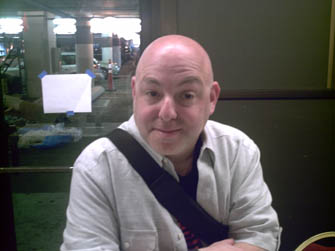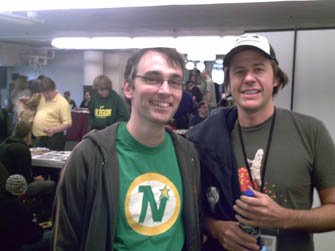
April 28, 2008
 Stumptown Comics Fest 2008 Report
Stumptown Comics Fest 2008 Report

 By Tom Spurgeon
By Tom Spurgeon
There are several types of comics conventions in North America, and many of them bleed into various hybrids of one sort or another. The two show varieties that see the most national press attention are the major industry cons and the regional arts festivals. The major industry cons (
Comic-Con International,
New York Comic-Con,
WizardWorld Chicago) tend to feature the bigger comics businesses and those related hobby companies that wish to reach their shared demographic, interspersed with hobby retailers and several of the smaller companies who can count on enough of a mass audience that their demographic is ably represented, while any cracks get filled in by artists and professionals who work with those companies at all levels. They can be big or simply bloated; suffused with junky energy or stuffed with slough-like junk.
Arts festivals (
Stumptown,
MoCCA Festival,
SPX) tend to be smaller in nature and feature either a limited array of publishers or none at all. The artist and sometimes the artist-serving publisher is the star here, as if the Artist's Alley of the larger comic book conventions leapt up from its backroom ghetto and took the bigger space like so many vampires at a scary, metal mesh-floor blood disco. At its best, a small press show can fire the imagination of the local audience in terms of comics' possibilities and the power of creative expression over corporate positioning. At their worst, it's a way for small-press artists and others ignored at the bigger shows to feast on a Station Casinos-level version of the Wynn-class ego buffet where more popular artists occasionally dine, only in many of these cases the small pressers do so without the a la carte order of craft.
Stumptown is most significantly distinguished by its being in Portland, Oregon. Portland was North America's last great city of the 20th Century and its best, thus far, of the 21st. Unlike many resurgent cities of the modern era, Portland's climb into laid-back livability has been as much about bottom-up and middle-across improvements as it has been top-down floods of corporations making it rain. It's a city of small houses, brightly colored on the inside, owned by hipsters 25-45 and families both large and small, near neighborhoods of rough buildings and slight, pungent urban decay. Young couples hit a foodstand in an empty lot in a mixed-race neighborhood on a Sunday morning. Two older men in tracksuits laugh and one of them points to say hello on a Saturday afternoon walk. I can't imagine getting out of college right now and wanting to go anywhere else. It's kind of the anti-Dubai.
Portland is also the home to dozens of cartoonists, a good sign for a city as comics folk can live practically anywhere and are drawn like flies when a comfortable and cosmopolitan city reaches that tipping point where it's discussed on chatboards and in the blogs of early adopters. What's interesting about Portland's assumption of the Comics Town USA title is that it does so without offering a gigantic number of hometown opportunities the way New York, LA or even Kansas City might. There is a small set of newspaper illustration gigs and a few proud local comic book companies where one might assume proximity could be helpful in gaining their attention, but for the most part the comics outfits here in town think nationally/internationally and just live here like everyone else. Comics thrives in the Rose City because Portland fits comics people, and because the large number of working artists has given them a voice and provided their city with another identity in a time when those kinds of things are still important.
Stumptown took place in a convention room exhibit hall or two connected to the Doubletree at Lloyd Center. The core room was a main hall about six aisles wide with front and back aisles completing a square around the floor. Dark Horse anchored the area along the front wall; Fantagraphics could be found along the back.
Scott McCloud and
Larry Marder anchored a mini-'80s independent comics portion of the show to the upper right from the door. About seven or eight people down a long row of tables from McCloud, Portland-area local and mainstream comics icon
Brian Michael Bendis met fans. Among the more prominent multiple-artist set-ups were
Sparkplug and a row of
Periscope Studios artists. There were scattered appearances from artists from out of town.
Shaenon Garrity and
Andrew Farago, planning to attend this year's
Reubens in a few weeks, were there from San Francisco, as were a group cajoled into attendance by
Matt Silady;
Jim Blanchard and a few of his astonishing prints made the trip down from Washington state. Los Angeles provided the show with
Josh Simmons and
Robert Goodin.

The best features of the show were the incredibly mellow vibe, like a very nice Saturday morning arts bazaar, and the general sound of money exchanging hands at a respectable although not intense rate. The crowds were friendly and on the average a bit more than good-looking (not something I'm ever able to figure out, but people kept mentioning this so I assume it's true) young people in the 20-35 year old age group. The crowds failed to skew towards any one set of tendencies common within the art form as much as they were capricious and even idiosyncratic in a way that you usually don't see at comics show. At approximately 4 PM, a group sitting with their backs against the wall where much of the crowd was visible noted that Brian Bendis was speaking to a group of three men while Scott McCloud held court with a crowd of six. Fresh indy faces like
Tim Sievert were shaking hands about 20 feet away from where early '90s alt-comics mainstay
JR Williams was selling some of his bright, attractive newer artwork. (Hopefully someone will reprint and collect
Crap soon; Williams is a natural, greatly underrated cartoonist.) Fantagraphics fielded maybe the youngest team I've ever seen the publisher send to a show; heck, even their late-Sunday surprise alumni guest visit was from someone who'd been gone from the publisher less than a half-decade and who looked 15: former FBI art director Carrie Whitney, who told me which fellow, one-time employee she'd gladly run over in her car were she old enough to drive.

There was a smattering of publishing news, but I'm not sure how much of it could be made official. Larry Marder announced at his panel he would be partnering with
Dark Horse on the upcoming re-launch of his Beanworld properties. This includes old work and new, merchandising and publications. Speaking of Dark Horse, Mike Richardson walked by and I grabbed him to talk for a bit. He was very gracious about his guest-blogging role here last week, and is currently in the midst of advance PR for the movie
Hellboy 2. The aforementioned Robert Goodin is doing a book through
Top Shelf. A lot of people caught up with various comics and trades from the Sparkplug group, including new, full-length books like Alixopoulos'
The Hot Breath of War. As far as I could tell,
Karl Stevens took a six-hour smoke break.
Kip Manley was sporting a seersucker suit on Sunday afternoon. Someone needs to hire Jesse Hamm for comics as well as illustration work.
Colleen Coover claimed she was mixing it up with Marvel fandom assembled through her latest contribution to
X-Men: First Class. T Edward Bak has moved back to Portland after a period of time in Vermont, Jeff Parker baffled the younger generation with airline jokes, and
Douglas Wolk spoke in very quiet tones.
I got to meet the talented, far-too-infrequent-writer-about-comics
Steve Duin, who just penned this piece about Bob Levin's
Most Outrageous and found the book as remarkable as I did. I tried to praise an older work of Duin's by quirkily insulting it first ("a lot of people thought this and avoided that book, but then they discovered this great thing about it"), and pretty much failed with that in spectacular fashion; too much insult, too little quirk and far too little reward. Sorry, Steve! Duin made an interesting point about how many of the good comics he found at the show he simply wasn't seeing before running into them at a show like this one. And he lives and works in the comics store-stuffed Portland area!

Many people I spoke to liked the new, "cute"
Comics Journal. I quite liked the
Scott Campbell prints on sale, even if they were out of my price range. Vancouver's
Jonathon Dalton probably had the closest thing to a buzz book, a full-color work in an accordion-style format that other cartoonists kept promoting.
Josh Simmons had buttons featuring personalities in his forthcoming work, including Rosie O'Donnell and Paul Lynde.
Shannon Wheeler was sporting a jaunty cap and I encourage everyone out there to hand him a camera and ask him to take their convention photos because watching him do it while muttering under his breath is pretty darn funny. Scott McCloud -- happy about the recently released cover to the forthcoming
Zot! collection -- pointed out the difference between panels that are helpful and panels that make people think they're experts and never use an offered service.
Comic Book Legal Defense Fund Executive Fund Executive Director Charles Brownstein was there without a booth, although his suit generated its own, overpowering New York vibe.
Tom Devlin once made the point that the best thing about shows like Stumptown is the 15-25 year olds considering making comics that have this kind of show as one of their early exposures to the form. This, Devlin suggests, should be a better experience than the Holiday Inn basement StinkCons people of our generation had burned into their eyeballs at a tender age. I think he's right.
In general, Stumptown 2008 was a low-key show with low-key participants and low-key results. I found most people working the con to be attentive and professional. Part of that is an old-fashioned booth strategy that emphasizes face-out contact with people as they arrive at your table, and part of it is likely that folks are simply relaxed and doing their jobs as people come to them instead of making a presentation or wrangling a number of meetings or herding elements on an empty floor space. Stumptown does what it does a lot better than most shows do what they do, and at a manageable cost for most cartoonists. Portland's big independents show provides a modest showcase for a variety of talents and allows those hard-working folks access to a marketplace that serves a surprisingly significant array of needs. It could all go away in a single year, with an unfortunate facilities move or a different mix of creators, but right now it's the kind of show that Scott McCloud pointed out likely generates lifetime memories for many of its participants and I imagine makes for a pleasant Spring afternoon arts experience for much of its audience.
*****
Also Recommended: Steve Duin's coverage
*****
* Rob Goodin's art
* Brian Michael Bendis
* Karl Stevens
* Shannon Wheeler
* Graham Annable and Scott Campbell (below)
*****

*****
*****
posted 8:20 am PST |
Permalink
Daily Blog Archives
November 2019
October 2019
September 2019
August 2019
July 2019
Full Archives


